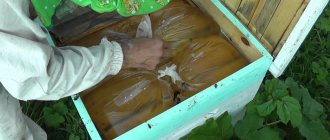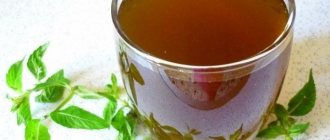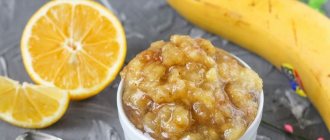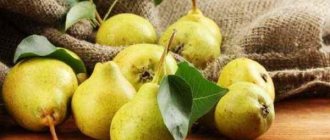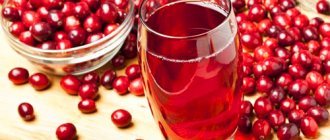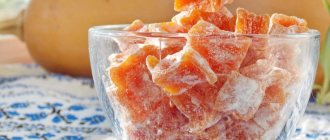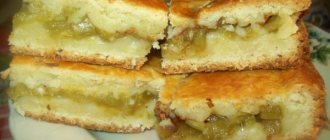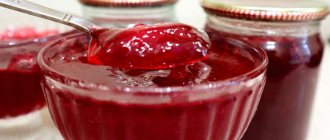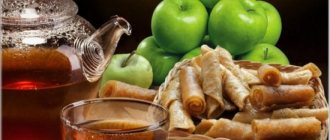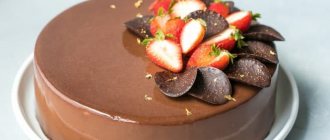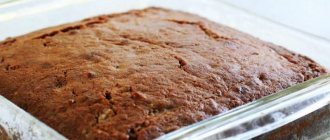Preparation
Large photos Small photos
Note
Do not cook the syrup for too long as it will change color from light to dark and take on a caramel flavor.
If, after adding soda, foam remains on the surface of the syrup for a long time (longer than 15 minutes), taste the syrup. If it is sour, it means that not all citric acid has been neutralized. Add some water and heat it up.
Boil the syrup in a heavy-bottomed saucepan with a tight-fitting lid to minimize evaporation.
Store the finished syrup in a well-tightened glass jar at room temperature.
Did you know that:
Invert syrup is used not only as a substitute for molasses in home baking. Many manufacturers of cakes, pastries, and bread use it in production, as indicated in the ingredients.
A little chemistry
. Invert syrup is obtained by hydrolytic splitting of sucrose into fructose and glucose. In other words, as a result of the slow boiling of sugar syrup with citric acid (inversion), sucrose is split into glucose and fructose in equal quantities.
No strain of yeast can process beet or cane sugar in its pure form. First, yeast spends time breaking down (hydrolyzing) sugar molecules into simpler substances - saccharides, and only then decompose the resulting substances into the alcohol and carbon dioxide we need. A moonshiner can perform hydrolysis artificially, thereby obtaining a number of advantages. The technique is similar to making regular syrup.
Inverting sugar
- the process of splitting one molecule of sucrose in beet or cane sugar into two molecules of fructose and glucose. At home, this is done under the influence of citric acid, which acts as a reaction catalyst, and high temperature (above 80°C). The composition of inverted syrup is close to natural honey.
Benefits of sugar inversion:
1. Fermentation proceeds faster; as a result, the mash accumulates fewer harmful impurities, which are a by-product of the work of yeast. All other things being equal, moonshine can be obtained a couple of days earlier.
2. Invert sugar does not deteriorate the organoleptic properties (taste and aroma) of grain and fruit brews as much as regular sugar. Its use in a mixture with any fruit (berry) and starch-containing raw materials is preferable.
3. High temperature kills microorganisms on the surface of the sugar, as a result, the risk of contaminating the mash with pathogenic fungi is sharply reduced.
4. When using classic distillers (moonshine stills), the quality of the finished product is slightly higher due to the initially smaller amount of impurities in the mash. For distillation columns this does not matter.
Disadvantages of invert sugar:
1. Additional time is spent preparing mash. You need to create a high temperature.
2. During the inversion, furfural appears - a toxic liquid with the smell of rye bread or almonds, which in high concentrations causes irritation of the mucous membranes and skin. But this substance is released only during the hydrolysis of hemicellulose, a polysaccharide contained in plant cells, of which there is little in pure sugar.
In any homemade jam, the furfural content is much higher than with the correct inversion technology, so the harm of inverted sugar is greatly exaggerated. Caramelizing berries and fruits is much more dangerous than making syrup.
3. The yield of moonshine with invert sugar is a couple of percent lower.
Summarize
- Invert sugar is a liquid sweetener made from table sugar (sucrose) and water.
- It is formed when the bonds between sugars in sucrose are broken, resulting in a thick, sweet syrup consisting of 50% fructose and 50% glucose.
- Invert sugar adds sweetness and helps improve moisture retention and quality in a variety of sweets such as ice cream, cakes, cookies and candies.
- Food grade invert sugar is similar to any other type of sugar, such as table sugar or corn syrup. You should consume it in small quantities as excessive consumption can lead to negative health effects.
- If you want to try using invert sugar, you can buy it online or try making it at home.
Tags: Sugar
- Related Posts
- How is brown sugar different from white sugar?
- What is clover honey? Application, composition and beneficial properties
- 50 Common Types of Sugar and Their Names
« Previous entry
Invert Sugar Recipe
Inversion is accompanied by active foam release, so it is important to choose the right container. After mixing water and sugar, it is desirable that at least a third of the volume remains free.
Proportions: to invert 1 kg of sugar, 0.5 liters of water and 3-4 grams of citric acid are required. The amount of acid only affects the reaction speed (time to prepare the syrup) and does not affect the quality of the moonshine.
Ingredients:
- sugar – 3 kg;
- water – 1.5 liters;
- citric acid – 9-12 grams.
Cooking technology:
1. Heat water in a large saucepan to 70-80°C.
2. Slowly add sugar, stirring constantly.
3. Bring the mixture to a boil, simmer for 10 minutes, skimming off the white foam. You should get sugar syrup of a homogeneous consistency.
4. Reduce heating power to a minimum. Slowly (very important) add citric acid. Mix.
When acid is added, the syrup immediately begins to foam. If you pour in too quickly, the contents of the container will splash out!
5. Close the pan with a lid and increase the heating intensity. Boil the syrup for 60 minutes at a temperature not lower than 80°C. You can maintain boiling water, this is a guarantee of a positive result.
6. Cool the finished invert sugar to 30°C, then pour into a fermentation container.
7. Add 4 liters of water and 100 grams of pressed (20 grams of dry) yeast per 1 kg of regular sugar (before inversion).
8. Install a water seal (preferably), maintain the fermentation temperature at 18-31°C (optimal – 26-30°C).
9. Distill the finished mash.
The video shows a slightly different method of inverting sugar, in which a minimal amount of furfural is released.
When you see words like glucose syrup, molasses, or corn syrup in a recipe, do you immediately close the recipe? But you can prepare invert syrup at home from simple and affordable products and replace any of these rare ingredients!
What is invert syrup used for? It will be useful for making marshmallows, marshmallows, it can be used in bread recipes and even replace glucose syrup in a mirror glaze recipe. I will not describe the chemical reactions that occur during the cooking of syrup, I will only tell you what the main difference between invert syrup and regular sugar is. Invert syrup has anti-crystallization properties; in other words, baked goods, marshmallows, cream or ganache prepared with this syrup will not become sugary during storage and will remain in their original form longer.
I will give three options for preparing invert syrup, the ingredients are the same, there are slight differences in the preparation technology.
How to cook at home
Take a saucepan with a thick bottom and a tight-fitting lid without a hole for steam to escape. Pour water (150 ml) into a saucepan, add sugar (350 g), and over medium heat, without covering and stirring, wait until the sugar dissolves.
Add citric acid (2 g.)
As soon as the syrup boils, reduce the heat to low, cover tightly with a lid and cook the syrup to a temperature of 108 C-110 C.
If you don't have a thermometer, use the cooking time as a guide; the process will take about 20 minutes. During this time, it is better not to lift the lid. The color of the finished syrup, depending on the intensity of the fire, can range from light yellow to amber.
Add soda to the slightly cooled syrup to neutralize the citric acid in the syrup. An active reaction will occur, you will see foam that will settle after 20 minutes.
During this time, you need to stir the syrup several times so that the foam disperses faster.
If the foam has not completely gone away after half an hour, add 1 tablespoon of water and heat the syrup over the fire again. Perhaps the citric acid was too strong, so this amount of baking soda was not enough to neutralize the acid.
When the reaction is complete and the foam has subsided, the syrup can be poured into a jar for storage.
From this amount of ingredients, approximately 400 grams of finished syrup is obtained. It should be stored in a hermetically sealed jar at room temperature. Shelf life is about a month. The hot syrup is quite liquid, but after cooling completely it becomes thick and has a consistency similar to honey.
When you see words like glucose syrup, molasses, or corn syrup in a recipe, do you immediately close the recipe? But you can prepare invert syrup at home from simple and affordable products and replace any of these rare ingredients!
What is invert syrup used for? It will be useful for making marshmallows, marshmallows, it can be used in bread recipes and even replace glucose syrup in a mirror glaze recipe. I will not describe the chemical reactions that occur during the cooking of syrup, I will only tell you what the main difference between invert syrup and regular sugar is. Invert syrup has anti-crystallization properties; in other words, baked goods, marshmallows, cream or ganache prepared with this syrup will not become sugary during storage and will remain in their original form longer.
I will give three options for preparing invert syrup, the ingredients are the same, there are slight differences in the preparation technology.
The simplest invert syrup recipe
- Granulated sugar - 300 g
- Hot water - 130 ml
- Citric acid - 1 g (about 1/3 level teaspoon)
Place sugar in a saucepan, pour in hot water, cook, stirring, over medium heat. Bring to a boil, add citric acid, stir and reduce heat to low. Cover with a lid and cook for 25-35 minutes.
After about 25 minutes, check the readiness of the syrup; this can be done using a thermometer (the temperature should be 108 degrees) or test on a thick thread. Place a little syrup on a saucer of ice water, grab the drop between your thumb and forefinger and squeeze and unclench it several times. If you see a thread of syrup 4-5 mm thick, the syrup is ready; if the thread is thin, cook the syrup for another 10-15 minutes.
Cool the finished syrup and pour into a glass jar. Store at room temperature for up to a month or in the refrigerator for 2-3 months.
The finished syrup is similar to liquid honey, light yellow in color; after cooling it becomes thicker.
Recipe for invert syrup with baking soda
- Sugar - 350 g
- Hot water - 155 ml
- Citric acid - 2 g (2/3 tsp without a slide)
- Baking soda - 1.5 g (1/4 tsp without a slide)
Pour hot water over sugar and bring to a boil. Add citric acid to the syrup and cook over low heat at a barely noticeable boil for 45 minutes. Remove from heat, let cool slightly for 5-10 minutes. Dilute baking soda in half a teaspoon of water and add to the syrup, stir. The syrup will begin to foam a lot, as it should. After 5-10 minutes, foaming will stop. Strain the syrup through a sieve and pour into a jar.
A quick option for making invert syrup
- Sugar - 350 g
- Hot water - 150 g
- Soda - 5 g
- Lemon juice - 5 g
Place sugar, water and lemon juice in a saucepan and place over medium heat. Stirring constantly, bring to a boil and simmer for another minute without stirring. Cool the syrup for 5 minutes and add baking soda. Wait 5-7 minutes until the foaming stops, strain the syrup through a sieve. This is the cooking option I show in the video. This method of preparing syrup is good because it can be prepared quickly and the color of the finished syrup is almost transparent, like glucose syrup.
Invert syrup video recipe
Important points in preparing invert syrup are a pan with thick walls and minimal heat. If these conditions are not met, the syrup may quickly darken and you will get , which, of course, is also tasty, but is not suitable for our purposes. If there are no suitable dishes in the house, you can put a saucepan with syrup in a larger bowl of water. The result will be something like a water bath.
I hope the preparation of invert syrup at home will be successful, share your experience in the comments. Subscribe to the newsletter to find out more recipes with and without invert syrup, cook with pleasure!
Classic recipe
Invert syrup (the recipe can be implemented at home, either leaving it in its original form or adjusting it taking into account the health characteristics of specific people who will consume the finished product) is prepared according to the classic recipe in 45 minutes.
Invert syrup is a classic recipe.
To make invert syrup according to the classic recipe, the cook is recommended to use the following as the main ingredients:
| The product's name | Required amount | Possible replacement |
| Granulated sugar | 350 g | Cane sugar. When using an analogue, the finished invert syrup is less sweet. |
| Hot filtered water | 160 ml | Mineral water without gases. When using an analogue, invert syrup turns out less transparent. |
| Baking powder | 2 g | Baking soda. |
| Citric acid (crystalline) | 3 g | — |
The step-by-step process for preparing invert syrup should look like this:
- To begin, pour granulated sugar into a small saucepan with thick walls.
- Next, add water to the sugar, stir with a fork or hand whisk, then put on the fire and bring to a boil.
- You need to add citric acid to the main ingredients, stir and cover the workpiece with an airtight lid. It is recommended to cook invert syrup over low heat for 45 minutes without stirring.
- After the specified amount of time, the syrup must be removed from the heat, open the lid and let it brew for 15 minutes.
- After 15 min. baking powder should be added to the main ingredients (at the moment of mixing the ingredients, a chemical reaction will occur, accompanied by strong bubbling and the formation of a large amount of foam).
- As the syrup cools, the foam will become less, and when it cools completely, the foam will disappear completely, while the finished product will become transparent and homogeneous.
